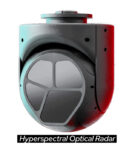During a recent military parade in Pyongyang, North Korea unveiled what appears to be a new loitering munition system closely resembling the Israeli-made IAI Harop. The appearance of this system suggests that Pyongyang is expanding its asymmetric strike capabilities with precision-guided kamikaze drones designed to target high-value assets such as radars and command centers.
Visual Confirmation of a Harop-Style Drone System
Imagery from the October 2025 parade shows a transporter-erector-launcher (TEL) vehicle carrying multiple canisterized munitions mounted on an elevated launch frame. The configuration and size of the canisters—approximately 2.5–3 meters long—strongly resemble those used for the Israeli IAI Harop loitering munition. Each TEL appears to carry six launch tubes arranged in two rows of three.
The design cues—such as canister dimensions and the angled launcher frame—indicate that North Korea may have reverse-engineered or indigenously developed a similar class of long-endurance loitering munition. The original IAI Harop is known for its autonomous flight capability (up to six hours), electro-optical/infrared (EO/IR) seeker for terminal guidance, and ability to strike radar emitters or static targets with high precision.
Implications for Regional Strike Capabilities
The deployment of such systems would mark a significant evolution in North Korea’s unmanned aerial capabilities. While Pyongyang has previously demonstrated rudimentary UAVs and short-range kamikaze drones—some reportedly based on Iranian or Chinese designs—the appearance of a Harop-class system suggests ambitions for deeper-strike missions against hardened or mobile targets.
If operational, these loitering munitions could be used to suppress enemy air defenses (SEAD), disrupt C4ISR nodes, or attack naval assets from standoff distances. Their mobility via TEL platforms increases survivability and enables rapid redeployment across different theaters.
Provenance and Technology Transfer Concerns
It remains unclear whether North Korea developed this system indigenously or acquired technical assistance from abroad. Given historical ties between Pyongyang and Tehran on missile technologies—and Iran’s own development of Shahed-series loitering munitions—it is plausible that some design elements were shared or adapted.
The Israeli IAI Harop has been exported widely (e.g., India, Azerbaijan), but no direct proliferation path to North Korea is known. However, open-source analysts have noted similarities between Iranian drones like the Shahed-136 and features seen in North Korean systems displayed in recent years. This raises concerns about illicit technology transfer networks circumventing international sanctions regimes.
Comparison with Known Systems
- IAI Harop: Range ~1,000 km; endurance ~6 hours; EO/IR seeker; anti-radiation capability; launched from ground-based canisters or aircraft.
- Shahed-136: Range ~1,000–2,000 km; GPS-guided; delta-wing design; used extensively by Russia in Ukraine under Geran-2 designation.
- DPRK Variant: Estimated range unknown; visual similarities suggest medium-range capability (~500–1000 km); likely EO-guided with limited autonomy.
The DPRK version lacks confirmed specifications but seems optimized for tactical-to-operational level strikes rather than strategic bombardment. Its TEL-based deployment mirrors Russian use of mobile Shahed launchers in Ukraine for saturation attacks on infrastructure and radar sites.
A Growing Trend Toward Kamikaze Drones
The appearance of this system underscores the global trend toward cost-effective precision strike via expendable UAVs. Loitering munitions offer militaries—especially those facing technological disadvantages—a means to bypass traditional air defenses through saturation tactics or stealthy approach profiles at low altitude.
For North Korea, which lacks advanced manned aircraft or satellite-guided cruise missiles at scale, such drones provide an asymmetric toolset capable of threatening South Korean or U.S.-allied forces’ critical nodes without risking pilots or expensive platforms.
Operational Readiness Still Uncertain
No flight footage or test data has been disclosed by state media regarding this new drone variant. Its presence at the parade may indicate either early operational status or psychological signaling aimed at deterrence rather than immediate battlefield deployment.
However, given previous patterns where systems debuted publicly before field trials (e.g., KN-23 SRBM), it is plausible that testing has occurred covertly within DPRK territory near Panghyon airfield or other known UAV development sites identified by satellite imagery analysts over the past year.










